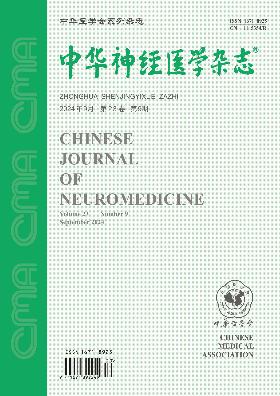Brain derived neurotrophic factor alleviates neuronal injury induced by ropivacaine through threonine protein kinase signaling pathway
Q4 Medicine
引用次数: 0
Abstract
Objective To investigate the protective effect of brain-derived neurotrophic factor(BDNF) on neuronal injury induced by ropivacaine (Rop) and its mechanism. Methods (1) Experiment one: 0, 1, 2, 3, 4 and 5 mmol/L Rop was used to stimulate SH-SY5Y cells for 48 h to induce neuronal injury; the morphological changes of the cells were observed under microscope; MTT assay was used to detect the cell activity; flow cytometry was used to detect the cell apoptosis, and immunohistochemistry was used to detect the expressions of protein kinase B (Akt) and proliferating cell nuclear antigen (PCNA). (2) Experiment two: SH-SY5Y cells were treated with 0, 1, 3, 5, 7 mmol/L Rop, respectively; the cell activity was measured 48 h after Rop treatment; the semi inhibitory concentration (IC50) of Rop was calculated by MTT assay; the SH-SY5Y cells were divided into control group (PBS for 48 h), Rop group (Rop at IC50 for 48 h), BDNF+Rop group (20 μg/L BDNF for 2 h, and Rop at IC50 for 48 h), Akt pathway activator SC79+Rop group (5 mg/L SC79 for 2 h, and Rop at IC50 for 48 h), and BDNF+Akt pathway inhibitor API-2+Rop group (20 μg/L BDNF+10 μmol/L API-2 for 2 h, Rop at IC50 for 48 h); the morphological changes of the cells were observed under microscope; MTT assay was used to detect the cell activity; flow cytometry was used to detect the cell apoptosis, and immunohistochemistry was used to detect the expressions of Akt and PCNA; the expressions of B lymphoma-2 (Bcl-2), Bcl-2-associated X (Bax) and cysteine protease-3 (Caspase-3) were detected by reverse transcription (RT)-PCR and Western blotting. Western blotting was used to detect the expressions of Akt and phosphatidylinositol 3-kinase (PI3K). Results (1) As compared with the 0 mmol/L Rop group, the 1, 2, 3, 4, and 5 mmol/L Rop group had significantly decreased cell activity, significantly increased apoptosis rate, and statistically smaller number of Akt and PCNA positive cells (P<0.05). (2) As compared with the control group, the Rop group had significantly decreased cell activity, statistically increased apoptosis rate, significantly smaller number of Akt and PCNA positive cells, significantly decreased Bcl-2 mRNA and protein expressions, significantly increased Bax and caspase-3 mRNA and protein expressions, and significantly decreased phosphorylated- (p-) Akt and p-PI3K protein expressions; as compared with the Rop group, the BDNF+Rop group and SC79+Rop group had significantly higher cell activity, significantly decreased apoptosis rate, significantly larger number of Akt and PCNA positive cells, significantly increased Bcl-2 mRNA and protein expressions, statistically decreased mRNA and protein expressions of Bax and Caspase-3, and significantly increased p-Akt and p-PI3K protein expressions (P<0.05); as compared with the BDNF+Rop group and SC79+Rop group, the BDNF+API-2+Rop group had significantly lower cell activity, significantly increased apoptosis rate, significantly smaller number of Akt and PCNA positive cells, significantly decreased Bcl-2 mRNA and protein expressions, statistically increased mRNA and protein expressions of Bax and Caspase-3, and significantly decreased p-Akt and p-PI3K protein expressions (P<0.05). Conclusion BDNF can alleviate ropivacaine-induced neuronal injury by activating Akt signaling pathway, consequently modulating the proliferation and apoptosis of neurons. Key words: Brain derived neurotrophic factor; Ropivacaine; Protein kinase B; Neuron脑源性神经营养因子通过苏氨酸蛋白激酶信号通路减轻罗哌卡因所致的神经元损伤
目的探讨脑源性神经营养因子(BDNF)对罗哌卡因(ropivacaine, Rop)所致神经元损伤的保护作用及其机制。方法(1)实验一:0、1、2、3、4、5 mmol/L Rop刺激SH-SY5Y细胞48 h诱导神经元损伤;显微镜下观察细胞形态变化;MTT法检测细胞活性;流式细胞术检测细胞凋亡,免疫组织化学检测蛋白激酶B (Akt)和增殖细胞核抗原(PCNA)的表达。(2)实验二:分别用0、1、3、5、7 mmol/L Rop处理SH-SY5Y细胞;Rop处理48 h后测定细胞活性;MTT法计算Rop的半抑制浓度(IC50);将SH-SY5Y细胞分为对照组(PBS作用48 h)、Rop组(IC50作用48 h)、BDNF+Rop组(20 μg/L BDNF作用2 h, IC50作用48 h)、Akt通路激活剂SC79+Rop组(5 mg/L SC79作用2 h, IC50作用48 h)、BDNF+Akt通路抑制剂API-2+Rop组(20 μg/L BDNF+10 μmol/L API-2作用2 h, IC50作用48 h);显微镜下观察细胞形态变化;MTT法检测细胞活性;流式细胞术检测细胞凋亡,免疫组织化学检测Akt和PCNA的表达;采用逆转录(RT)-PCR和Western blotting检测B淋巴瘤-2 (Bcl-2)、Bcl-2相关X蛋白(Bax)和半胱氨酸蛋白酶-3 (Caspase-3)的表达。Western blotting检测Akt和磷脂酰肌醇3激酶(PI3K)的表达。结果(1)与0 mmol/L Rop组相比,1、2、3、4、5 mmol/L Rop组细胞活性显著降低,凋亡率显著升高,Akt和PCNA阳性细胞数量明显减少(P<0.05)。(2)与对照组相比,Rop组细胞活性显著降低,凋亡率有统计学意义升高,Akt和PCNA阳性细胞数量显著减少,Bcl-2 mRNA和蛋白表达显著降低,Bax和caspase-3 mRNA和蛋白表达显著升高,磷酸化- (p-) Akt和p- pi3k蛋白表达显著降低;与Rop组比较,BDNF+Rop组和SC79+Rop组细胞活性显著升高,凋亡率显著降低,Akt和PCNA阳性细胞数量显著增多,Bcl-2 mRNA和蛋白表达显著升高,Bax和Caspase-3 mRNA和蛋白表达显著降低,P -Akt和P - pi3k蛋白表达显著升高(P<0.05);与BDNF+Rop组和SC79+Rop组比较,BDNF+API-2+Rop组细胞活性显著降低,凋亡率显著升高,Akt和PCNA阳性细胞数量显著减少,Bcl-2 mRNA和蛋白表达显著降低,Bax和Caspase-3 mRNA和蛋白表达显著升高,P -Akt和P - pi3k蛋白表达显著降低(P<0.05)。结论BDNF可通过激活Akt信号通路减轻罗哌卡因诱导的神经元损伤,从而调节神经元的增殖和凋亡。关键词:脑源性神经营养因子;Ropivacaine;蛋白激酶B;神经元
本文章由计算机程序翻译,如有差异,请以英文原文为准。
求助全文
约1分钟内获得全文
求助全文
来源期刊

中华神经医学杂志
Psychology-Neuropsychology and Physiological Psychology
CiteScore
0.30
自引率
0.00%
发文量
6272
期刊介绍:
 求助内容:
求助内容: 应助结果提醒方式:
应助结果提醒方式:


